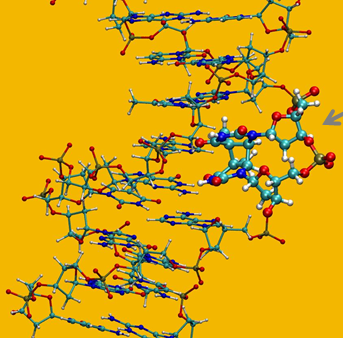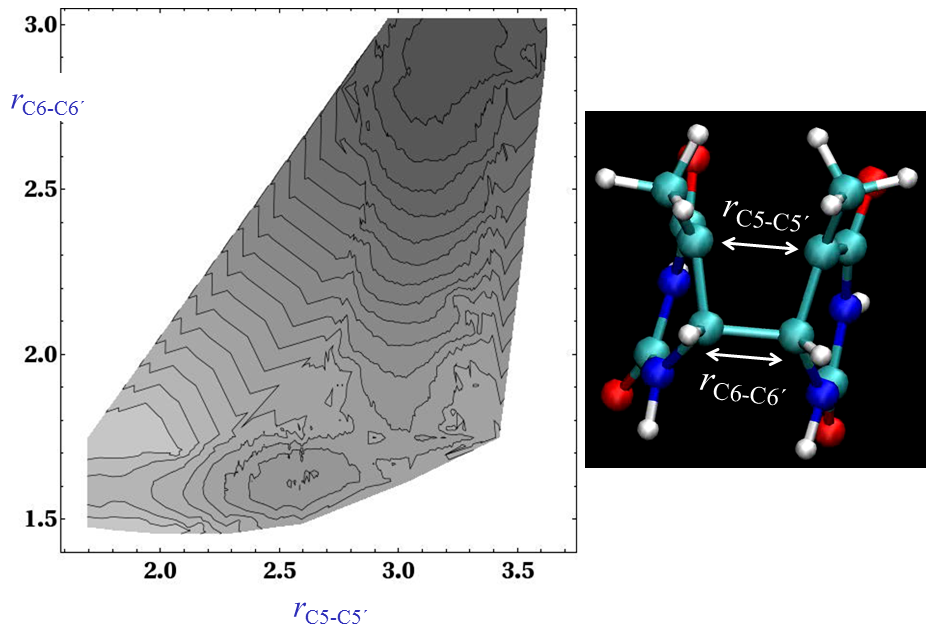cyclobutane pyrimidine dimer (CPD) repair
 The most common and lethal damage caused to DNA through
exposure to ultraviolet radiation is the formation of bonds between
two pyrimidine bases to form a cyclobutane pyrimidine dimer
(CPD). Unfortunately, CPD units, which lead to diseases like skin
cancer, are quite stable at room temperature.
The most common and lethal damage caused to DNA through
exposure to ultraviolet radiation is the formation of bonds between
two pyrimidine bases to form a cyclobutane pyrimidine dimer
(CPD). Unfortunately, CPD units, which lead to diseases like skin
cancer, are quite stable at room temperature.
 A more
realistic picture of DNA with a CPD lesion is shown to the left. Many
organisms, including some vertebrates (but not humans), posses an
enzyme, photolyase, which acts to repair CPD lesions. Photolyase is
activated by absorption of a photon, which in turn triggers the
transfer of an electron to the CPD site. While CPD units are very
stable, the CPD anion comparatively rapidly separates into two normal
pyrimidine bases. This offers exciting routes to the prevention of
skin cancer. (We don't endorse such products, but you can even buy
sunscreen that contains photolyase.) Naturally, this has generated an
enormous amount of interest in understanding the mechanism of CPD
repair.
A more
realistic picture of DNA with a CPD lesion is shown to the left. Many
organisms, including some vertebrates (but not humans), posses an
enzyme, photolyase, which acts to repair CPD lesions. Photolyase is
activated by absorption of a photon, which in turn triggers the
transfer of an electron to the CPD site. While CPD units are very
stable, the CPD anion comparatively rapidly separates into two normal
pyrimidine bases. This offers exciting routes to the prevention of
skin cancer. (We don't endorse such products, but you can even buy
sunscreen that contains photolyase.) Naturally, this has generated an
enormous amount of interest in understanding the mechanism of CPD
repair.
A significant amount of effort has gone into the study of the repair of model compounds in solution. Foregoing the complexity of the enzyme for the moment, we have theoretically studied the splitting of a thymine CPD anion in water. Because the reaction involves chemical bond breaking, we employed ab initio molecular dynamics simulations to study the reaction. One result of our studies was a reaction free energy surface for the splitting of the dimer. The surface shows how the C5-C5' bond splits before the C6-C6' bond.

One of the missing puzzle pieces has been the timing of back electron transfer in the repair of the CPD anion. The anion has to give up its electron at some point to complete the repair. However, if it gives it up too soon, the system reverts to the stable, neutral CPD. We have proposed a simple model to explain how the timing of back electron transfer depends on the solvent environment.
This research was supported by the National Institutes of Health.
relevant publications
- Ali A. Hassanali, Dongping Zhong, and Sherwin J. Singer, ``An AIMD study of the CPD dimer repair mechanism in water: reaction free energy surface and mechanistic implications'', J. Phys. Chem., (in press, 2011).
- Ali A. Hassanali, Dongping Zhong, and Sherwin J. Singer, ``An AIMD study of the CPD dimer repair mechanism in water: role of solvent in ring splitting'', J. Phys. Chem., (in press, 2011).